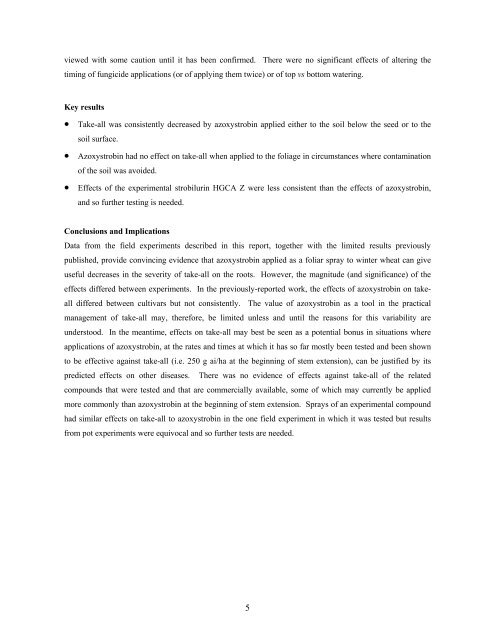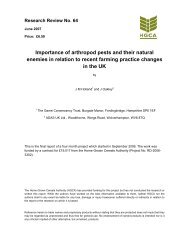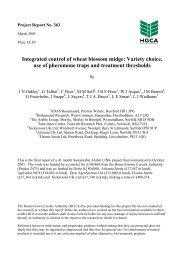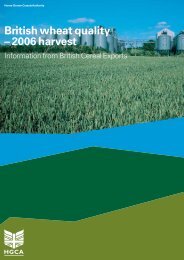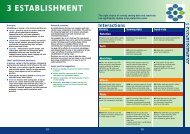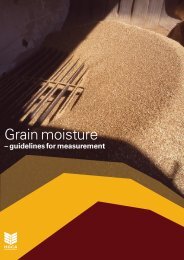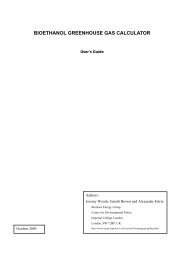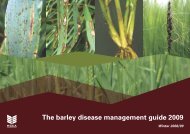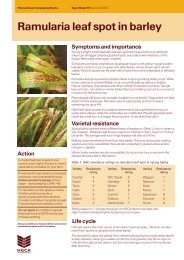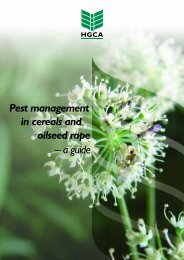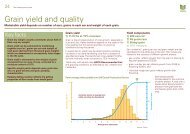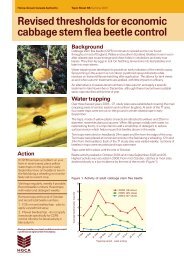viewed with some caution until it has been confirmed. There were no significant effects of altering thetiming of fungicide applications (or of applying them twice) or of top vs bottom watering.Key results• Take-all was consistently decreased by azoxystrobin applied either to the soil below the seed or to thesoil surface.• Azoxystrobin had no effect on take-all when applied to the foliage in circumstances where contaminationof the soil was avoided.• Effects of the experimental strobilurin <strong>HGCA</strong> Z were less consistent than the effects of azoxystrobin,and so further testing is needed.Conclusions and ImplicationsData from the field experiments described in this report, together with the limited results previouslypublished, provide convincing evidence that azoxystrobin applied as a foliar spray to winter wheat can giveuseful decreases in the severity of take-all on the roots. However, the magnitude (and significance) of theeffects differed between experiments. In the previously-reported work, the effects of azoxystrobin on takealldiffered between cultivars but not consistently. The value of azoxystrobin as a tool in the practicalmanagement of take-all may, therefore, be limited unless and until the reasons for this variability areunderstood. In the meantime, effects on take-all may best be seen as a potential bonus in situations whereapplications of azoxystrobin, at the rates and times at which it has so far mostly been tested and been shownto be effective against take-all (i.e. 250 g ai/ha at the beginning of stem extension), can be justified by itspredicted effects on other diseases. There was no evidence of effects against take-all of the relatedcompounds that were tested and that are commercially available, some of which may currently be appliedmore commonly than azoxystrobin at the beginning of stem extension. Sprays of an experimental compoundhad similar effects on take-all to azoxystrobin in the one field experiment in which it was tested but resultsfrom pot experiments were equivocal and so further tests are needed.5
TECHNICAL DETAILGENERAL INTRODUCTIONThe wheat take-all fungus (Gaeumannomyces graminis var. tritici) is, like all soil-borne, root-infecting fungi,a difficult target for fungicidal control. Although a number of well-established commercial fungicides areactive against the pathogen and have been shown to decrease the disease in field experiments at Rothamsted(Bateman, 1989), the amounts and methods of application (e.g. high volume soil drenches) that are needed,make their use uneconomic. Management of take-all has, therefore, relied largely on appropriate husbandry(Hornby et al., 1998).Recently, however, two fungicides, fluquinconazole (Wenz et al., 1998; Löchel et al., 1998) and silthiofam(Beale et al., 1998; Spink et al., 1998), which have useful activity against take-all when applied to the seed,have become available. Both provide only partial control of the disease but, when used as part of anintegrated disease management package, offer farmers the prospect of better disease control and greaterflexibility in cropping.Applying crop protection chemicals to the seed has a number of advantages. In particular, it allows their usein small amounts, and often helps to minimise the risk to non-target organisms but they offer little flexibilityin the amounts that can be applied and no flexibility in the timing of applications, in contrast to foliar sprays.However, the discovery of agrochemicals with the appropriate properties to move systemically from theleaves to the roots has proved very difficult. Amounts of chemical moving to the soil externally, as a resultof run-off, can usually be expected to be relatively small because formulations are designed to adhere to theleaves and to be rain-fast. Consequently, a cautious view was taken of evidence from an experiment atIACR-Rothamsted in 1998 that suggested significant decreases in take-all where azoxystrobin had beenapplied as a foliar spray. Occasional effects on take-all of fungicide sprays (or programmes of sprays) havebeen seen previously (e.g. Prew et al., 1995) but have, typically, proved impossible to repeat. However,further experiments in 1999, including one at Harper Adams University College, showed similar effects ofazoxystrobin on take-all (Jenkyn et al., 2000) suggesting that it was a real effect although the magnitude ofthe effect differed between experiments. There were also interactions with cultivars that were significant butinconsistent.Although azoxystrobin is known to be active against Gaeumannomyces spp. (e.g. Soika & Sanders, 1996), itseffects on take-all in the experiments reported by Jenkyn et al. (2000) are difficult to explain from itspredicted behaviour in plants and soil. Such effects may, nevertheless, contribute to yield responses in crops6


